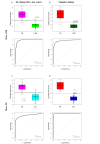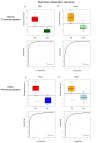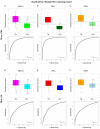Detection of tuberculosis in HIV-infected and -uninfected African adults using whole blood RNA expression signatures: a case-control study
- PMID: 24167453
- PMCID: PMC3805485
- DOI: 10.1371/journal.pmed.1001538
Detection of tuberculosis in HIV-infected and -uninfected African adults using whole blood RNA expression signatures: a case-control study
Abstract
Background: A major impediment to tuberculosis control in Africa is the difficulty in diagnosing active tuberculosis (TB), particularly in the context of HIV infection. We hypothesized that a unique host blood RNA transcriptional signature would distinguish TB from other diseases (OD) in HIV-infected and -uninfected patients, and that this could be the basis of a simple diagnostic test.
Methods and findings: Adult case-control cohorts were established in South Africa and Malawi of HIV-infected or -uninfected individuals consisting of 584 patients with either TB (confirmed by culture of Mycobacterium tuberculosis [M.TB] from sputum or tissue sample in a patient under investigation for TB), OD (i.e., TB was considered in the differential diagnosis but then excluded), or healthy individuals with latent TB infection (LTBI). Individuals were randomized into training (80%) and test (20%) cohorts. Blood transcriptional profiles were assessed and minimal sets of significantly differentially expressed transcripts distinguishing TB from LTBI and OD were identified in the training cohort. A 27 transcript signature distinguished TB from LTBI and a 44 transcript signature distinguished TB from OD. To evaluate our signatures, we used a novel computational method to calculate a disease risk score (DRS) for each patient. The classification based on this score was first evaluated in the test cohort, and then validated in an independent publically available dataset (GSE19491). In our test cohort, the DRS classified TB from LTBI (sensitivity 95%, 95% CI [87-100]; specificity 90%, 95% CI [80-97]) and TB from OD (sensitivity 93%, 95% CI [83-100]; specificity 88%, 95% CI [74-97]). In the independent validation cohort, TB patients were distinguished both from LTBI individuals (sensitivity 95%, 95% CI [85-100]; specificity 94%, 95% CI [84-100]) and OD patients (sensitivity 100%, 95% CI [100-100]; specificity 96%, 95% CI [93-100]). Limitations of our study include the use of only culture confirmed TB patients, and the potential that TB may have been misdiagnosed in a small proportion of OD patients despite the extensive clinical investigation used to assign each patient to their diagnostic group.
Conclusions: In our study, blood transcriptional signatures distinguished TB from other conditions prevalent in HIV-infected and -uninfected African adults. Our DRS, based on these signatures, could be developed as a test for TB suitable for use in HIV endemic countries. Further evaluation of the performance of the signatures and DRS in prospective populations of patients with symptoms consistent with TB will be needed to define their clinical value under operational conditions. Please see later in the article for the Editors' Summary.
Conflict of interest statement
The authors have declared that patent applications have been filed for the Disease Risk score (GB1201766.1) and TB/LTBI and TB/OD signatures (GB1213636.2).
Figures






Comment in
-
A transcriptional signature for active TB: have we found the needle in the haystack?PLoS Med. 2013 Oct;10(10):e1001539. doi: 10.1371/journal.pmed.1001539. Epub 2013 Oct 22. PLoS Med. 2013. PMID: 24167454 Free PMC article.
References
-
- Munthali L, Mwaungulu JN, Munthali K, Bowie C, Crampin AC (2006) Using tuberculosis suspects to identify patients eligible for antiretroviral treatment. Int J Tuberc Lung Dis 10: 199–202. - PubMed
-
- Aabye MG, Ravn P, PrayGod G, Jeremiah K, Mugomela A, et al. (2009) The impact of HIV infection and CD4 cell count on the performance of an interferon gamma release assay in patients with pulmonary tuberculosis. PLoS One 4: e4220 doi:10.1371/journal.pone.0004220 - DOI - PMC - PubMed
Publication types
MeSH terms
Substances
Grants and funding
LinkOut - more resources
Full Text Sources
Other Literature Sources
Medical
Molecular Biology Databases

